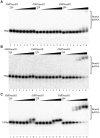Structural and functional studies of a noncanonical Dicer from Entamoeba histolytica
- PMID: 28317870
- PMCID: PMC5357909
- DOI: 10.1038/srep44832
Structural and functional studies of a noncanonical Dicer from Entamoeba histolytica
Abstract
RNaseIII proteins are dsRNA-specific endonucleases involved in many important biological processes, such as small RNA processing and maturation in eukaryotes. Various small RNAs have been identified in a protozoan parasite Entamoeba histolytica. EhRNaseIII is the only RNaseIII endonuclease domain (RIIID)-containing protein in E. histolytica. Here, we present three crystal structures that reveal several unique structural features of EhRNaseIII, especially the interactions between the two helixes (α1 and α7) flanking the RIIID core domain. Structure and sequence analysis indicate that EhRNaseIII is a noncanonical Dicer and it lacks a dsRBD in the C-terminal region (CTR). In vitro studies suggest that EhRNaseIII prefers to bind and cleave longer dsRNAs, generating products around 25 nucleotides in length. Truncation of the CTR or attaching the dsRBD of Aquifex aeolicus RNaseIII can enhance the binding and cleavage activities of EhRNaseIII. In combination with in vitro crosslinking assay, our results suggested that EhRNaseIII functions in a cooperative mode. We speculate that some partner proteins may exist in E. histolytica and regulates the activity of EhRNaseIII through interaction with its CTR. Our studies support that EhRNaseIII plays an important role in producing small RNAs in E. histolytica.
Conflict of interest statement
The authors declare no competing financial interests.
Figures







Similar articles
-
A Single RNaseIII Domain Protein from Entamoeba histolytica Has dsRNA Cleavage Activity and Can Help Mediate RNAi Gene Silencing in a Heterologous System.PLoS One. 2015 Jul 31;10(7):e0133740. doi: 10.1371/journal.pone.0133740. eCollection 2015. PLoS One. 2015. PMID: 26230096 Free PMC article.
-
Single processing center models for human Dicer and bacterial RNase III.Cell. 2004 Jul 9;118(1):57-68. doi: 10.1016/j.cell.2004.06.017. Cell. 2004. PMID: 15242644
-
Noncatalytic assembly of ribonuclease III with double-stranded RNA.Structure. 2004 Mar;12(3):457-66. doi: 10.1016/j.str.2004.02.004. Structure. 2004. PMID: 15016361
-
Structural basis for non-catalytic and catalytic activities of ribonuclease III.Acta Crystallogr D Biol Crystallogr. 2006 Aug;62(Pt 8):933-40. doi: 10.1107/S090744490601153X. Epub 2006 Jul 18. Acta Crystallogr D Biol Crystallogr. 2006. PMID: 16855311 Review.
-
Structure and function of Rnt1p: An alternative to RNAi for targeted RNA degradation.Wiley Interdiscip Rev RNA. 2019 May;10(3):e1521. doi: 10.1002/wrna.1521. Epub 2018 Dec 11. Wiley Interdiscip Rev RNA. 2019. PMID: 30548404 Review.
Cited by
-
RISC in Entamoeba histolytica: Identification of a Protein-Protein Interaction Network for the RNA Interference Pathway in a Deep-Branching Eukaryote.mBio. 2021 Oct 26;12(5):e0154021. doi: 10.1128/mBio.01540-21. Epub 2021 Sep 7. mBio. 2021. PMID: 34488447 Free PMC article.
-
Hippo/MST blocks breast cancer by downregulating WBP2 oncogene expression via miRNA processor Dicer.Cell Death Dis. 2020 Aug 21;11(8):669. doi: 10.1038/s41419-020-02901-3. Cell Death Dis. 2020. PMID: 32820148 Free PMC article.
-
The origin of RNA interference: Adaptive or neutral evolution?PLoS Biol. 2022 Jun 29;20(6):e3001715. doi: 10.1371/journal.pbio.3001715. eCollection 2022 Jun. PLoS Biol. 2022. PMID: 35767561 Free PMC article.
-
Functional Characterization of Entamoeba histolytica Argonaute Proteins Reveals a Repetitive DR-Rich Motif Region That Controls Nuclear Localization.mSphere. 2019 Oct 16;4(5):e00580-19. doi: 10.1128/mSphere.00580-19. mSphere. 2019. PMID: 31619501 Free PMC article.
-
Genetic Insight into the Domain Structure and Functions of Dicer-Type Ribonucleases.Int J Mol Sci. 2021 Jan 9;22(2):616. doi: 10.3390/ijms22020616. Int J Mol Sci. 2021. PMID: 33435485 Free PMC article. Review.
References
-
- Hutvagner G. & Zamore P. D. RNAi: nature abhors a double-strand. Curr Opin Genet Dev 12, 225–232 (2002). - PubMed
-
- Nicholson A. W. Function, mechanism and regulation of bacterial ribonucleases. FEMS Microbiol Rev 23, 371–390 (1999). - PubMed
-
- MacRae I. J., Zhou K. & Doudna J. A. Structural determinants of RNA recognition and cleavage by Dicer. Nat Struct Mol Biol 14, 934–940 (2007). - PubMed
-
- Kawamata T. & Tomari Y. Making RISC. Trends Biochem Sci 35, 368–376 (2010). - PubMed
Publication types
MeSH terms
Substances
LinkOut - more resources
Full Text Sources
Other Literature Sources

